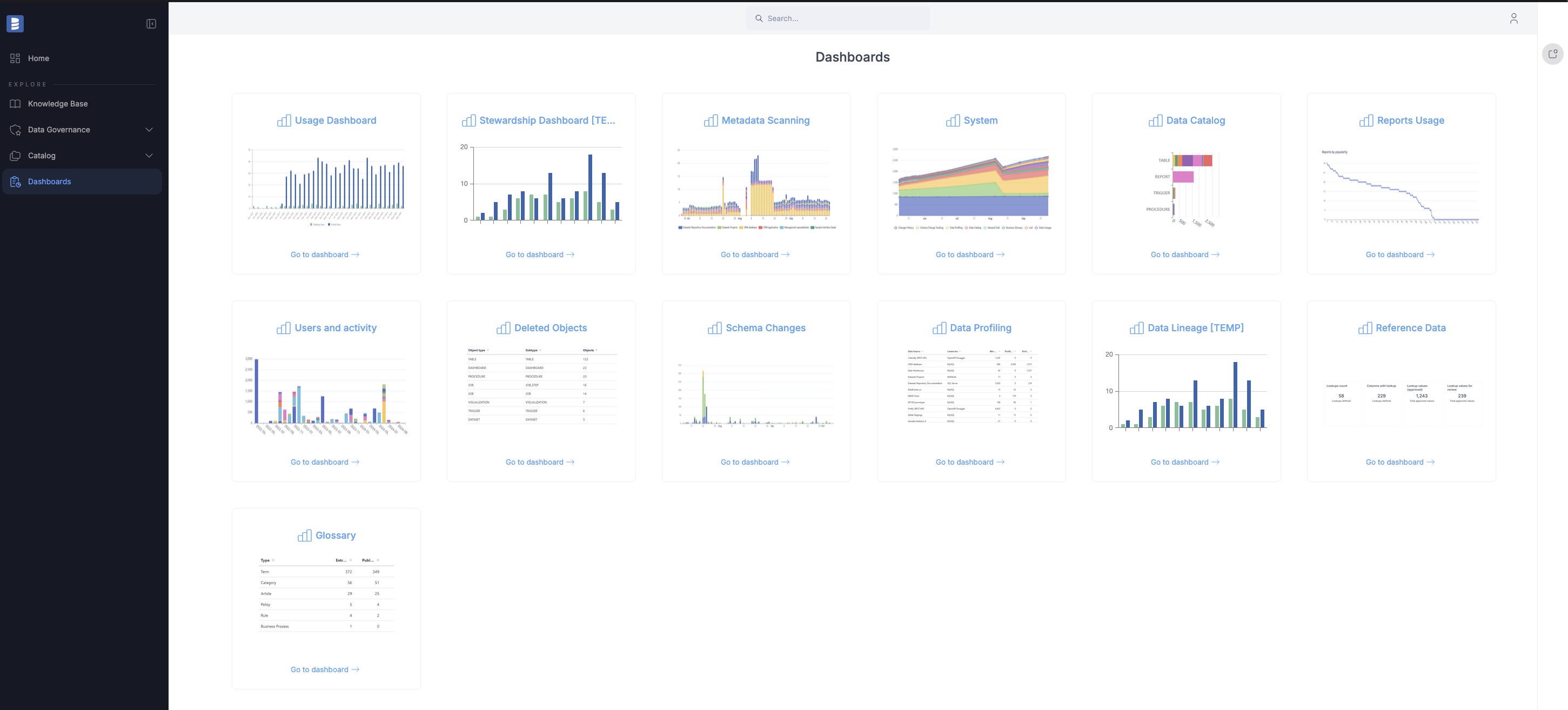Meet Dataedo
Dataedo helps businesses bring clarity to their complex data landscapes. Let’s explore the challenges it addresses and how it supports organizations in making confident, data-driven decisions.
Challenge–Navigating complex data ecosystems
Data is the fuel on which modern companies run. It’s the cornerstone of meaningful decision-making, business and product development. It creates value for employees while fostering customer satisfaction and loyalty. Yet, with vast amounts of data generated daily, data management can easily become a liability, even for smaller and mid-size businesses.
Without proper data governance, data ecosystems can quickly become hard to navigate, hindering effective decision-making for an organization. Similarly, without up-to-date database documentation, development teams risk errors and inefficiencies when adapting to evolving database schemas. These challenges prevent businesses from unlocking the full potential of their data.
Solution–Simplify data management with Dataedo
Dataedo tackles these challenges by simplifying the management of complex data environments. It structures and documents data assets—like databases, data warehouses, and data lakes—capturing key details such as table structures, relationships, data lineage, and metadata.
This approach preserves critical knowledge, even as team members change, and ensures organizations stay audit-ready. By improving data quality and accessibility, Dataedo bridges the gap between business and IT, and helps companies harness their data’s full potential, facilitate collaboration, and boost productivity.
Govern your data with Dataedo
Dataedo is designed to make managing and governing your data easier and more efficient. Here’s how it can help your organization:
Dataedo features at a glance
Glossary
A shared vocabulary is essential for understanding and working with data. Without consistent definitions, different interpretations can lead to confusion and misalignment. Dataedo Glossary helps your organization define key terms, ensuring clarity and consistency in data discussions.
The Glossary serves as a centralized repository for business terms, definitions, policies, and rules. Using a standard set of terms, teams can collaborate more effectively and maintain consistency in data interpretation.
Key features of Glossary include:
- Terms management helps you define and organize business terms with descriptions, synonyms, and ownership details to ensure consistency across teams.
- Business terms mapping is useful for linking terms to data assets, clarifying how business concepts are represented in the data.
- Category organization groups terms into categories and hierarchies to improve navigation and manage large glossaries.
- Collaboration and feedback allows users to comment, ask questions, and rate terms, ensuring accurate definitions.
- Search and history tracking helps you find terms quickly and track changes for transparency and governance.
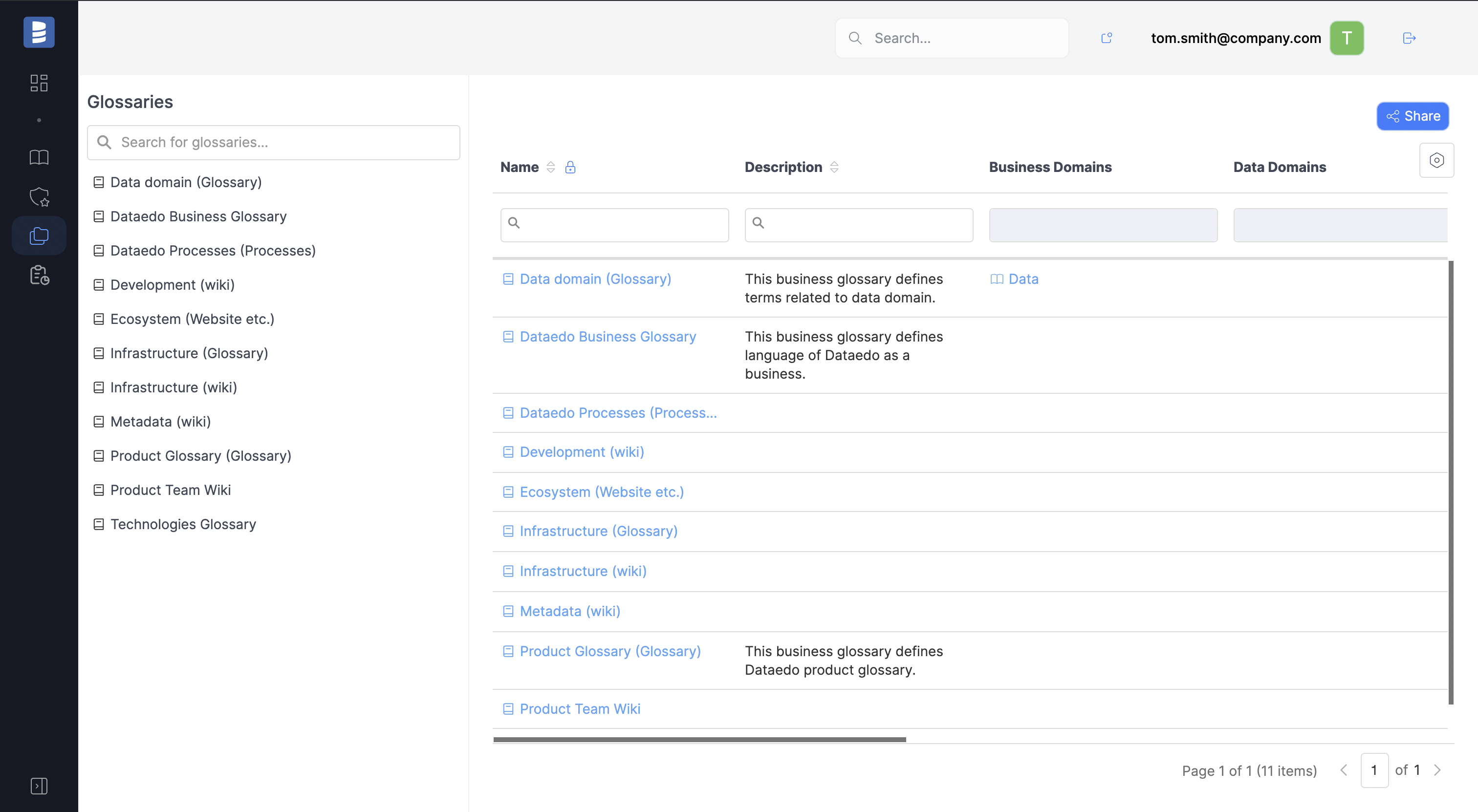
Catalog
The Catalog helps your organization build data literacy and streamline data management. Using Catalog, you can map business terminology to physical assets, visualize data relationships through ER diagrams, and organize critical data, including glossaries, reference data, and master data.
The Catalog simplifies data discovery with powerful search capabilities, ensures transparency with data lineage, and centralizes information from multiple data sources. Features such as the Report Catalog, badges, and other collaboration tools in the Catalog foster a shared understanding of data, and improve productivity and decision-making across teams in your organization.
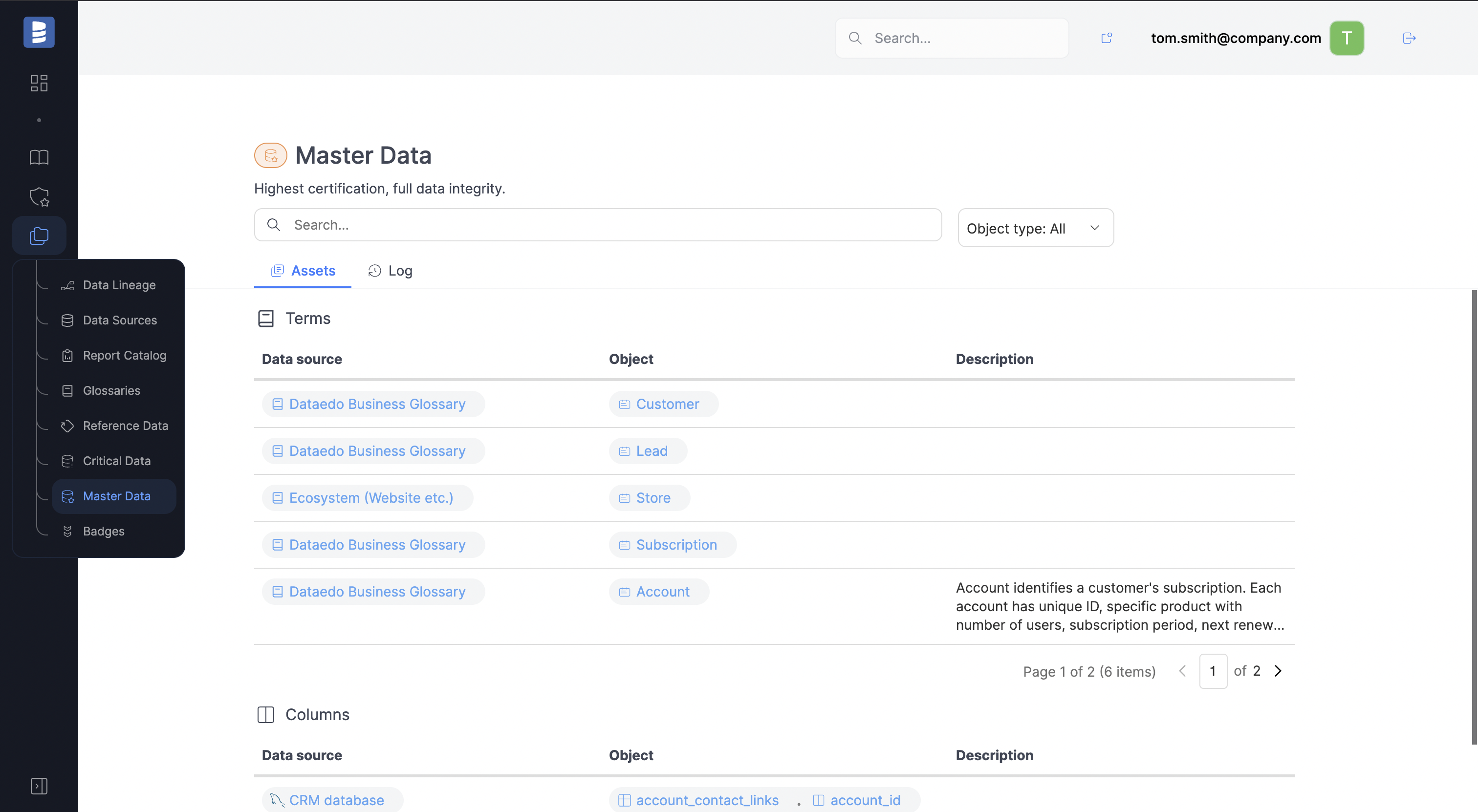
Data lineage
Understanding how data flows through your organization is crucial for maintaining accuracy, troubleshooting issues, and streamlining development. Dataedo Data Lineage addresses these challenges by providing a clear map of your data's journey—from origin to destination—helping you trace sources, identify errors, and understand transformations.
Dataedo captures Data Lineage at four levels:
- Object-level: Mapping tables to specific data sets in your system.
- Column-level: Providing detailed insights into how columns relate and transform data.
- Source-level: Tracking data relationships for individual sources.
- System-level: Offering a comprehensive view of connections across all databases.
Data Lineage can be automated, extracted from code-defined relationships, or manually configured.
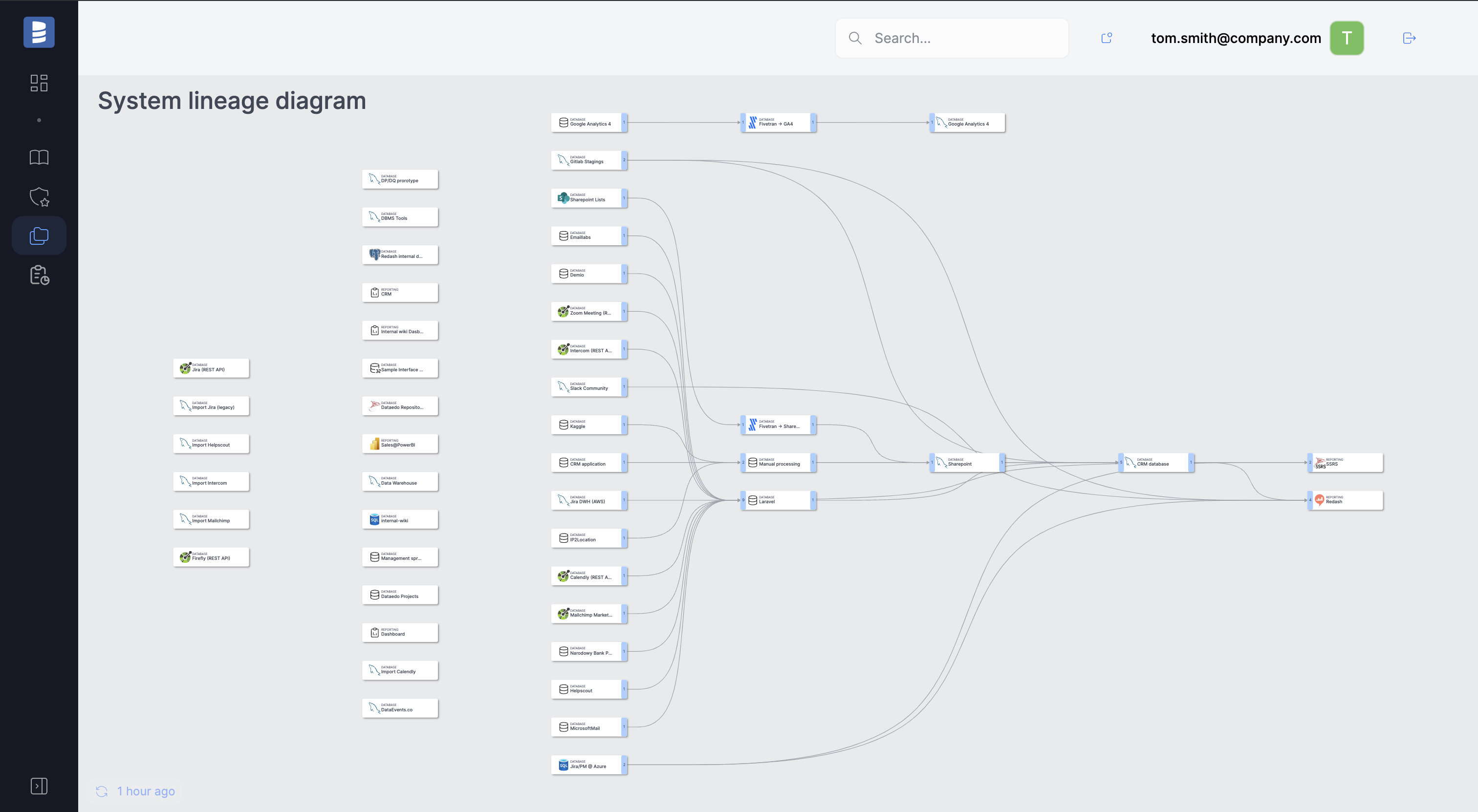
Data Profiling
Dataedo Data Profiling tool delivers a thorough understanding of your data by analyzing actual database values and simplifying the evaluation of data structure and quality. It generates detailed statistics and metrics, such as minimum, maximum, average values, row counts, and distribution patterns. Statistic also include column distribution analysis by nullability and uniqueness, along with profiling for numeric, string, and date data types.
Data Profiling also lets you assess string lengths, review the most frequent or random values in a column, and preview sample data from your tables. Dataedo performs these analyses efficiently by leveraging database-level calculations to minimize data transfer.
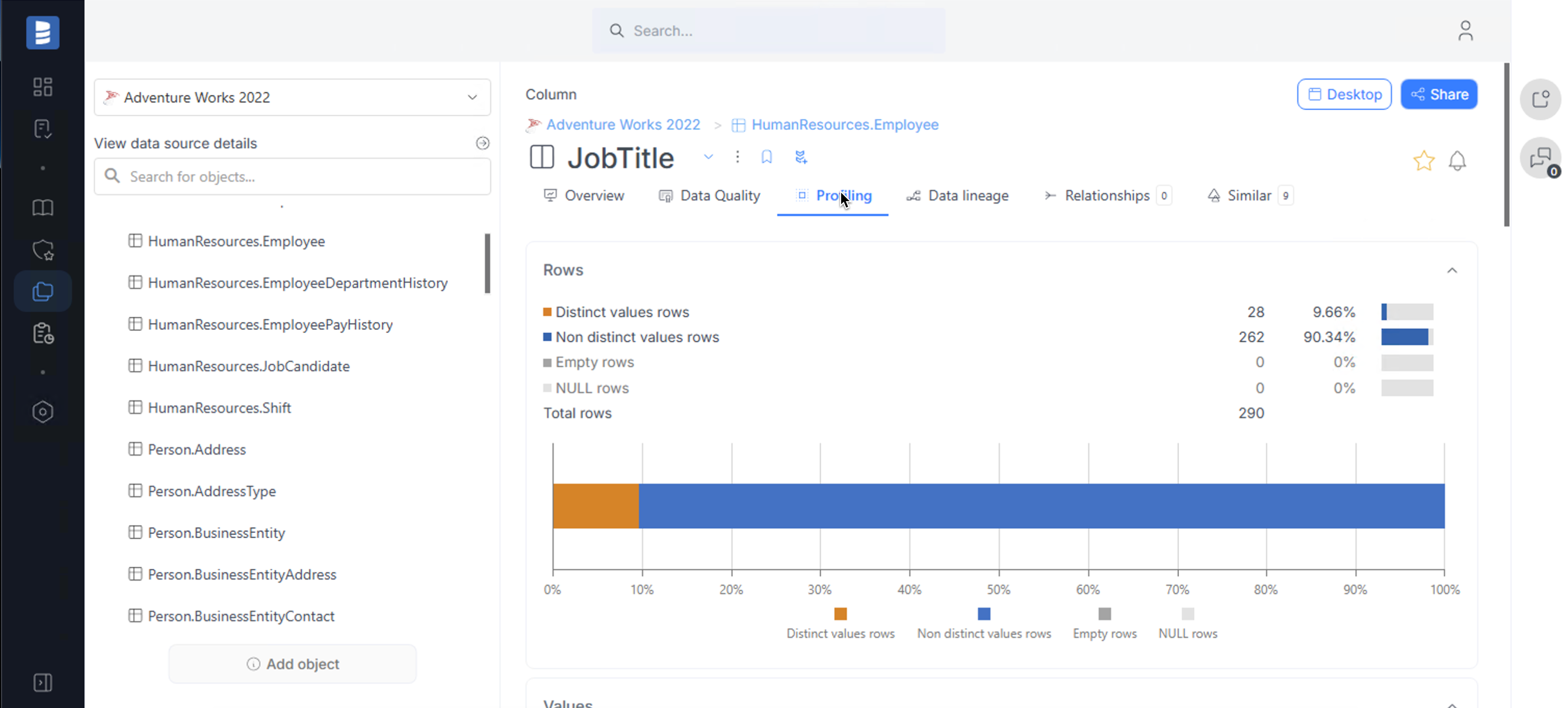
Data Quality
For every organization, data can be its greatest asset—or its biggest obstacle. Without strong Data Quality, issues like duplicate customer records, inaccurate billing, and inconsistent reports can quickly erode trust, slow decision-making, and create compliance risks. What should be a strategic advantage can become a costly problem.
Dataedo Data Quality ensures your data is accurate, consistent, complete, and reliable—qualities essential for confident business decisions. This feature allows you to define what “good data” means for your business, automate validation processes, and proactively address issues before they escalate.
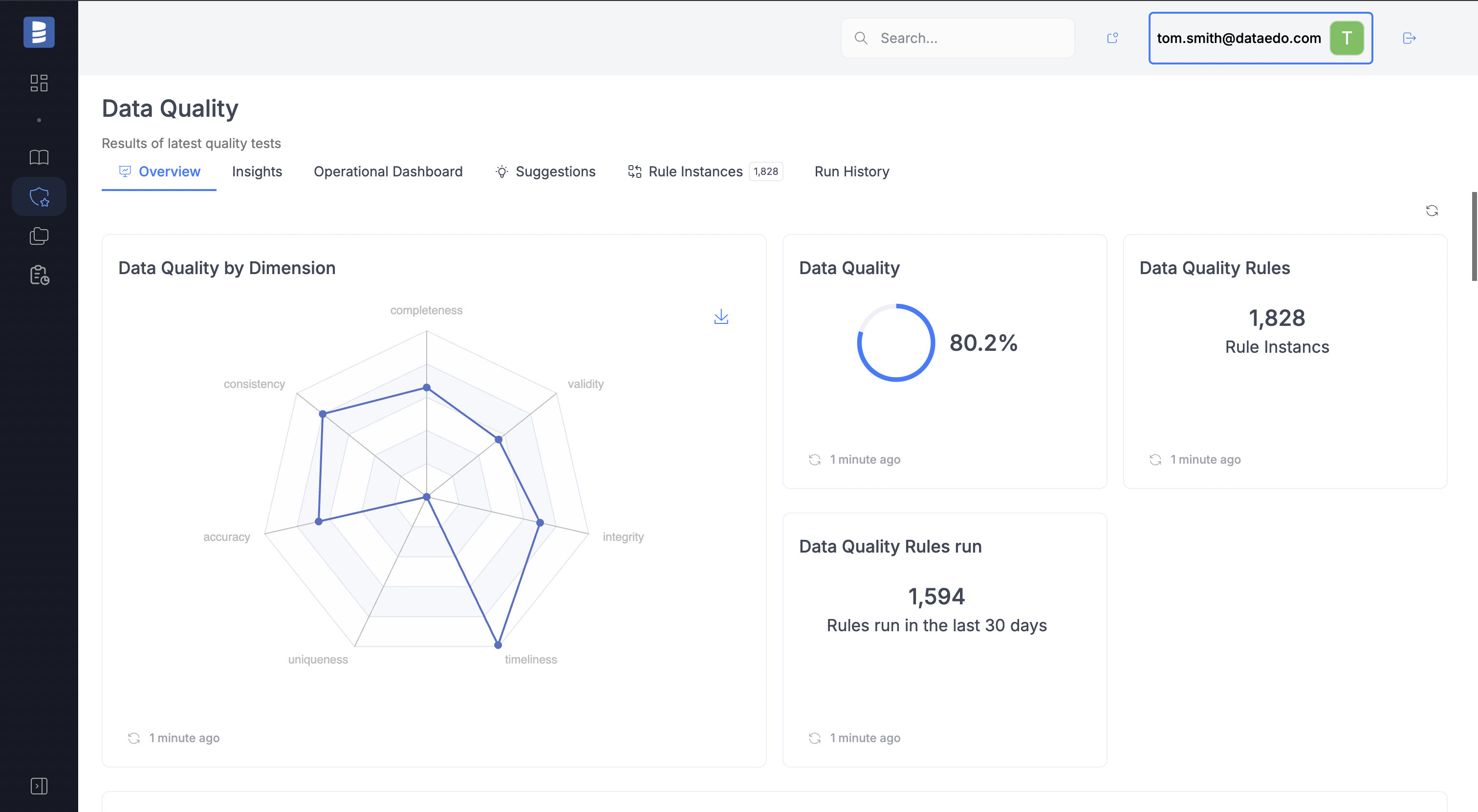
Reference Data
Reference Data is essential for organizing, classifying, and labeling other data in a consistent manner. It can be particularly useful for managing enumeration fields in databases, such as dropdowns, checkboxes, or radio buttons used for simple classifications. Also referred to as codes, lookups, lists of values, or domains, reference data is a subset of Master Data that plays a vital role in ensuring data quality. Common examples of reference data include countries, currencies, account types, units of measure, organizational departments, statuses, and calendar periods.
Using Reference Data you can organize these lookups with detailed lists of allowed values and their corresponding formats, making it easier to manage and maintain consistency. Users in your organization can review, modify, and publish these values as needed, ensuring their accuracy and reliability. Additionally, Dataedo provides the ability to trace which database columns use specific values, offering greater transparency.
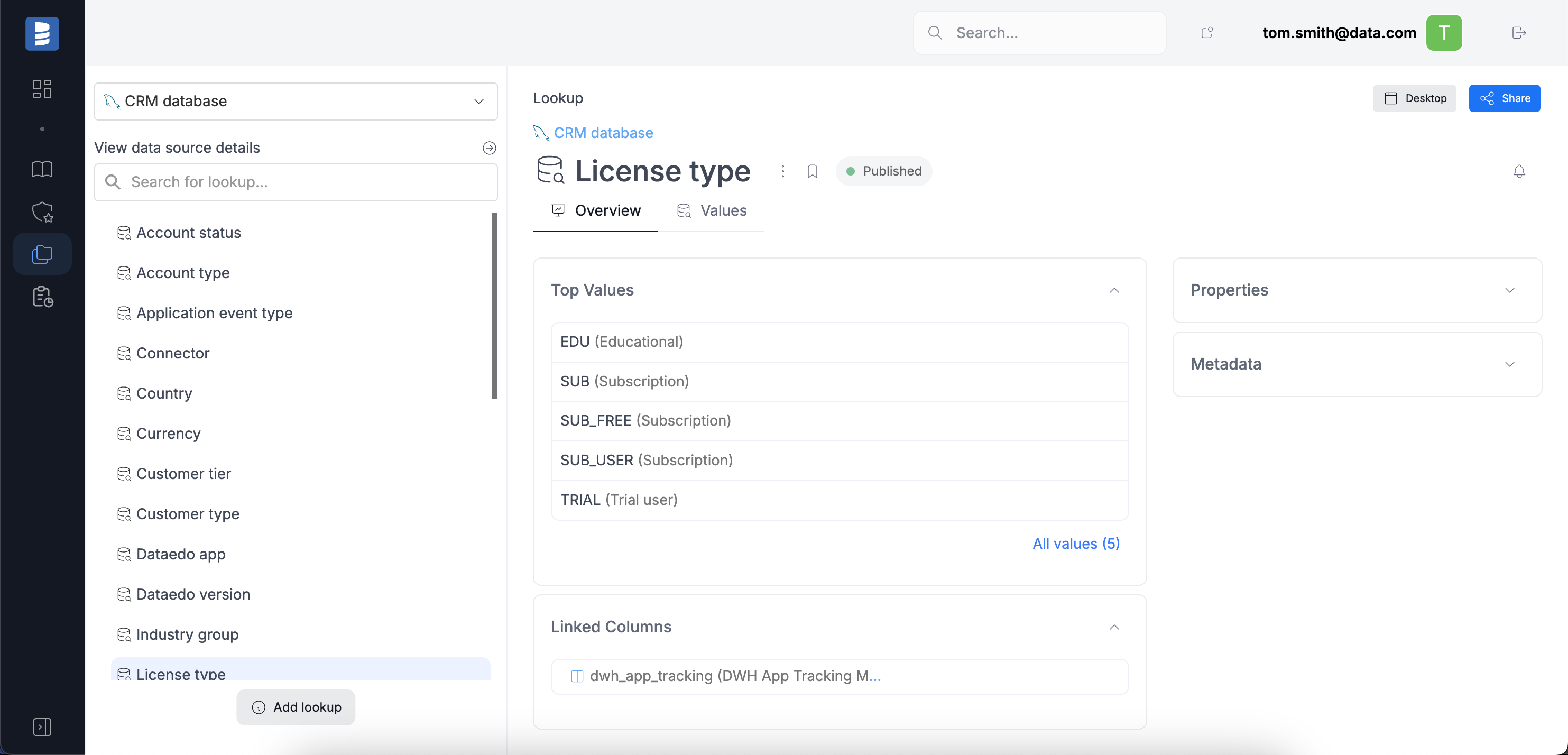
Knowledge Base & Domains
Keeping track of your organization's growing data assets can quickly become chaotic without a clear structure. Domains provide a scalable solution by organizing and categorizing data assets, enabling logical navigation, access control, and alignment between business and technical perspectives.
Dataedo leverages Domains to organize and structure data assets with the following key features:
- Asset organization: Group data assets independently of their sources for flexible categorization.
- Hierarchical subject areas: Organize with up to three levels of nested subject areas.
- Access control: Assign permissions to domains and subject areas with automatic inheritance.
- Business-focused navigation: Explore data using an intuitive, wiki-like domain hierarchy.
There are two types of domains available in the system: Business Domains and Data Domains, each serving distinct purposes.
Business Domains
Business Domains organize data according to how the business is structured, such as by departments, hierarchies, or specific business processes. They serve as an entry point for users to access data and concepts related to these organizational structures, understand various areas and workflows, and navigate a clear, hierarchical view of the business.
Data Domains
Data Domains and Business Domains work together to create a comprehensive framework for organizing and navigating your organization's data. While business domains provide a high-level, hierarchical view of business processes, data domains focus on the technical grouping of data assets based on sources, systems, or technologies. You can use data domains to represent Data Mesh domains or different departments, teams, applications, modules, or even data products.
Together, with Business domains, Data domains connect business and technical perspectives, enabling seamless collaboration, improved data discoverability, and better alignment between data management and organizational goals.
Scheduler
Keeping your repository and data quality checks up to date manually can be time-consuming and error-prone. The Dataedo Scheduler solve these problems by automating tasks in your Dataedo repository. By utilizing the Dataedo Agent, it facilitates hands-free scheduling and execution of operations such as importing schema changes, refreshing data profiling or triggering automated data quality runs. Scheduler runs ensure that your repository stays up to date with minimal manual intervention.
The Scheduler helps you with:
- Task creation: Define tasks with custom schedules, connection details, and execution parameters via a guided wizard.
- Automation: Tasks are executed automatically by Dataedo agents based on their schedules.
- Task management: Easily edit, trigger, or delete tasks, and validate configurations for reliable operation.
- Progress tracking: Monitor task progress with states like Scheduled, Enqueued, Processing, Succeeded, or Failed.
Steward Hub
Steward Hub simplifies data management by automating suggestions for new objects, relationships, and group links, making metadata documentation faster and more effective. It allows you to easily link tables, views, and terms to Domains through group linking, accept suggestions for primary keys, relationships, and lookups to enrich your documentation, and track progress with dashboards. Clear navigation and well-organized content with hyperlinks support a smooth and efficient workflow.
Workflows
Workflows in Dataedo help in managing of manual objects like terms, domains, and lookups by assigning them statuses and guiding them through defined stages, from initial idea to final approval and publication. Fully customizable to reflect your organization's processes, workflows ensure clarity, accountability, and consistency in handling metadata. With features like the Steward Hub, users can easily review, track, and update object statuses while being notified of pending actions, fostering efficient collaboration and maintaining control over data visibility.
Connectors
Dataedo integrates with a variety of data sources through connectors, making it easy to document and manage your data from different platforms. This overview provides a look at all available connectors and how they can streamline your data management process.
 Microsoft Access
Microsoft Access Apache Hbase
Apache Hbase Apache Hive
Apache Hive Apache Impala
Apache Impala Apache Spark
Apache Spark Astra DB
Astra DB Amazon Aurora
Amazon Aurora Amazon Athena
Amazon Athena Amazon DynamoDB
Amazon DynamoDB Amazon Keyspaces
Amazon Keyspaces Amazon Redshift
Amazon Redshift Azure SQL Database
Azure SQL Database Azure Cosmos
Azure Cosmos Azure Synapse Analytics
Azure Synapse Analytics Google BigQuery
Google BigQuery Cassandra
Cassandra ClickHouse
ClickHouse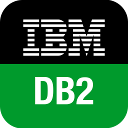 IBM Db2
IBM Db2 IBM Db2 for z/OS
IBM Db2 for z/OS IBM Db2 LUW
IBM Db2 LUW IBM Db2 on Cloud
IBM Db2 on Cloud IBM Db2 Big SQL
IBM Db2 Big SQL IBM Db2 Warehouse
IBM Db2 Warehouse IBM Db2 Warehouse on Cloud
IBM Db2 Warehouse on Cloud IBM Db2 for iSeries
IBM Db2 for iSeries IBM Informix
IBM Informix Interbase
Interbase Elasticsearch
Elasticsearch Firebird
Firebird Hortonworks
Hortonworks Neo4j
Neo4j Percona MySQL
Percona MySQL SAP Advantage Database Server
SAP Advantage Database Server SAP IQ
SAP IQ SAP Hana
SAP Hana SAP Sybase ASE
SAP Sybase ASE SQLite
SQLite Teradata
Teradata Vertica
Vertica Google Cloud SQL
Google Cloud SQL Amazon RDS
Amazon RDS Snowflake
Snowflake MySQL
MySQL PostgreSQL
PostgreSQL Azure Data Factory
Azure Data Factory Dbt
Dbt Fivetran
Fivetran Hevo
Hevo SSIS
SSIS Coalesce
Coalesce Apache Avro
Apache Avro Apache ORC
Apache ORC Apache Parquet
Apache Parquet CSV
CSV Delta Lake
Delta Lake Microsoft Excel
Microsoft Excel JSON
JSON XML
XML Azure Data Lake
Azure Data Lake Amazon S3
Amazon S3 Oracle e-Business Suite
Oracle e-Business Suite Salesforce
Salesforce Databricks Hive Metastore
Databricks Hive Metastore Oracle PeopleSoft
Oracle PeopleSoft Amazon QuickSight
Amazon QuickSight Analysis Services Multidimensional
Analysis Services Multidimensional Analysis Services Tabular
Analysis Services Tabular Power BI
Power BI Qlik Sense
Qlik Sense Redash
Redash SAP BO
SAP BO SSRS
SSRS Tableau
Tableau Azure Machine Learning
Azure Machine Learning MLflow
MLflow Apache Atlas
Apache Atlas Azure Blob Storage
Azure Blob Storage Microsoft Azure
Microsoft Azure Cloudera
Cloudera Microsoft Dataverse
Microsoft Dataverse AWS Glue Data Catalog
AWS Glue Data Catalog Hive Metastore
Hive Metastore Interface tables
Interface tables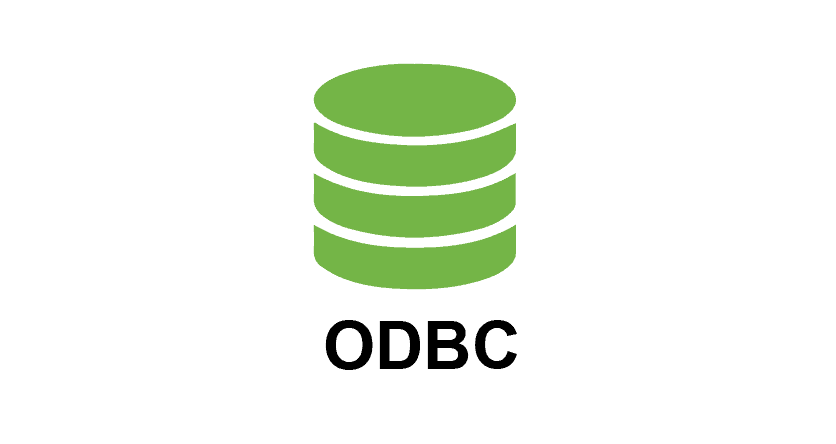 ODBC
ODBC OpenAPI spec
OpenAPI spec SQL DDL
SQL DDL Open Lineage
Open Lineage Purview
Purview Starburst/Trino
Starburst/Trino Microsoft Fabric
Microsoft FabricUser types
Dataedo also offers a variety of user roles, each with specific permissions tailored to different responsibilities within the platform. Below are the descriptions of each role and the actions they can perform in Dataedo.
Other features
Certificates and Badges
Tag assets like tables, columns, and reports with predefined Badges such as Critical Data or Master Data, or create custom badges. These tags allow for easy categorization and help pinpoint essential data elements across your organization.
Community
The Data Community module in Dataedo Portal allows your team members to collaboratively document and discuss assets. Users can leave comments, ask questions, tag items with warning badges, and rate assets like tables or modules, fostering smoother collaboration and capturing institutional knowledge.
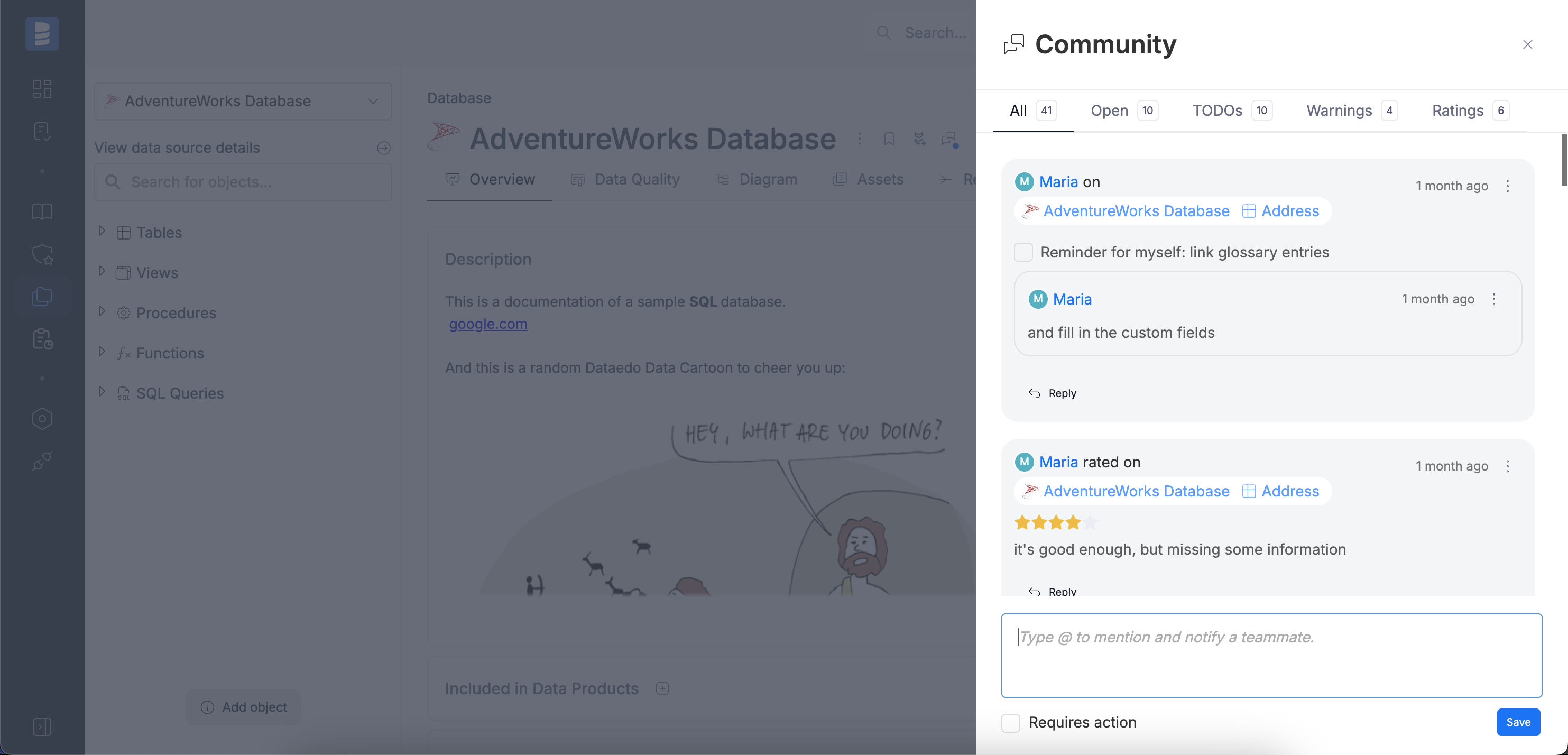
AI Autodocumentation
Dataedo uses Large Language Models (LLMs) like OpenAI’s GPT to automate the documentation of glossary terms, KPIs, tables, views, and columns. This feature saves time and ensures metadata consistency, available with Dataedo Unlimited plans.
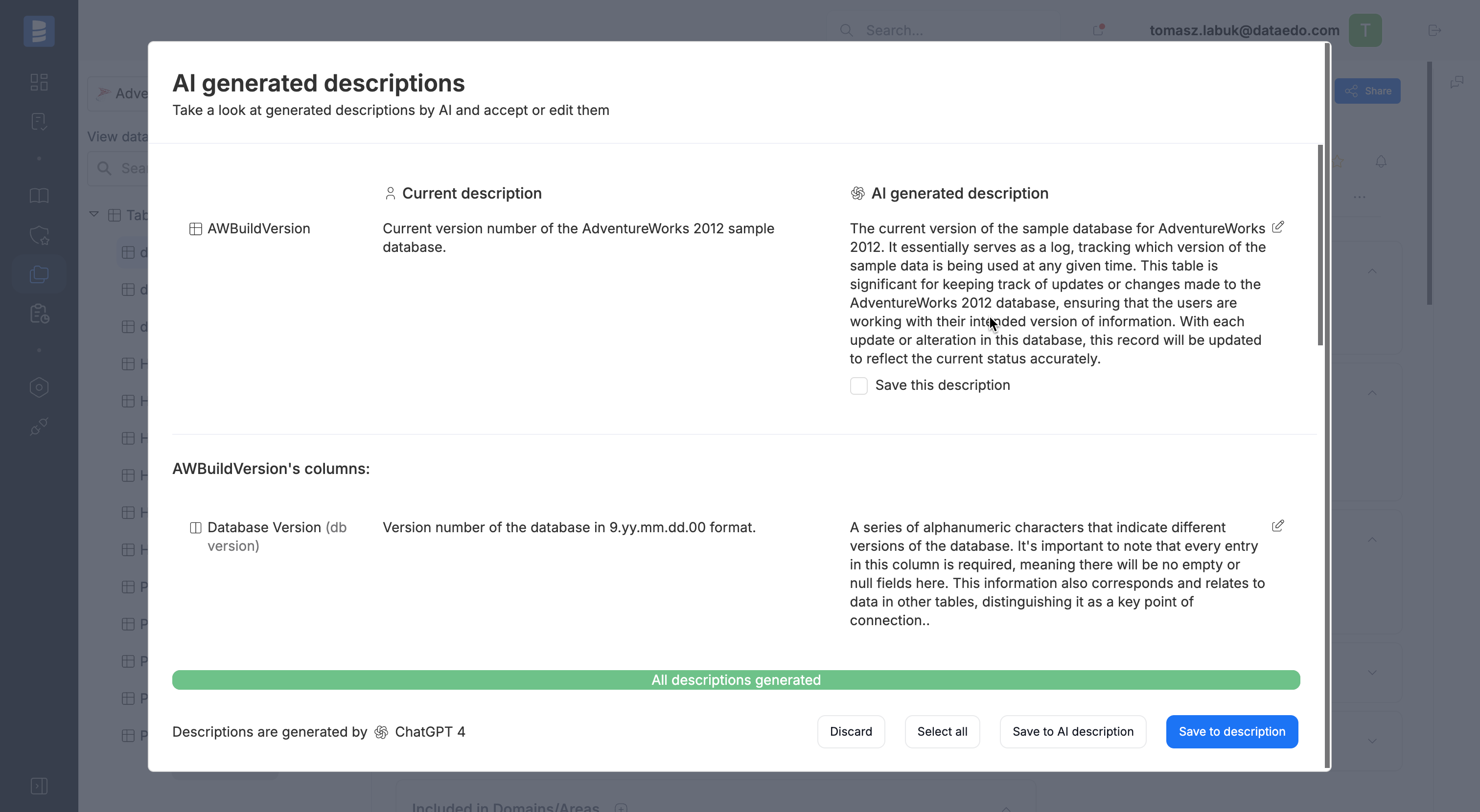
Dashboards
Dataedo offers various Dashboards to provide insights into your repository, data catalog, and usage:
| Dashboard | Description |
|---|---|
| System Dashboard | Overview of repository size, keyword counts, table counts, user changes, and version installations. |
| Metadata Scanning Dashboard | Summarizes imports and changes from the last 90 days, showing sources, connectors, and import statuses. |
| Data Catalog Dashboard | Displays catalog objects grouped by type and data source for easy navigation. |
| Reports Usage Dashboard | Highlights popular reports and identifies unused ones for optimization. |
| Deleted Objects Dashboard | Shows deleted objects grouped by data source and type. |
| Schema Changes Dashboard | Tracks schema modifications with a timeline chart and recent updates in a grid. |
| Data Profiling Dashboard | Displays profiling information for tables and objects, grouped by data source. |
| Reference Data Dashboard | Lists reference data statistics and lookups for validation. |
| Glossary Dashboard | Organizes glossary entries by type and glossary for easy access. |
